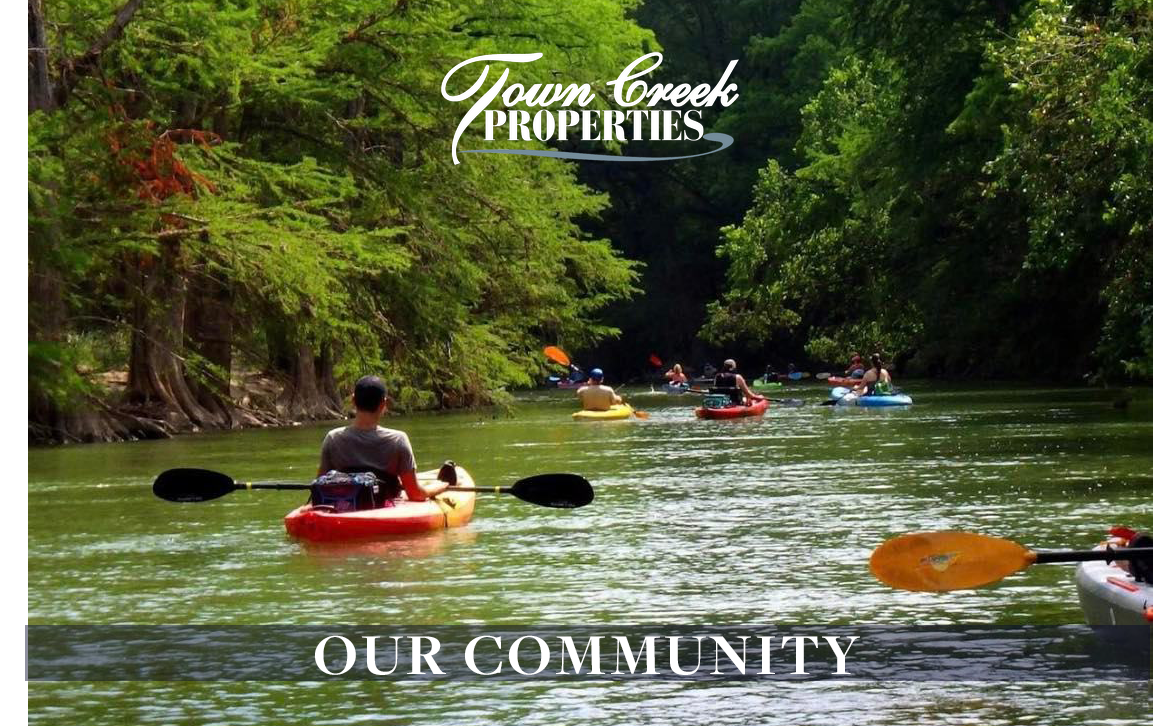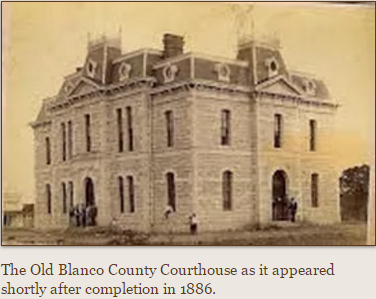
Johnson City, Blanco County, Texas
The Founding of Johnson City and its History
Settlers living along the Pedernales River in the rugged central part of the county, among them one James Polk Johnson, for whom the town was later named, thought that the county seat at Blanco was not accessible, so in 1876 they called for an election to move the courthouse closer to the geographical center of the county. When this attempt failed, the citizens followed Johnson's lead and began publicizing the idea of establishing a new community. The site chosen was on land originally granted to James Fentress, which belonged to Johnson. A post office was established there in 1878, and soon afterwards town lots were offered for sale. In 1879 the people successfully petitioned for an election to choose a new county seat but were defeated. Meanwhile, the town continued to grow, especially boosted by the construction of Johnson's two-story office building and his hotel. He also donated lots for schools. In 1890 another county seat election, a hotly contested one, made Johnson City the county seat.
Though its new status boosted the economy of the community, Johnson City did not get modern utilities until the 1930s, when Lyndon Baines Johnson, a relative of the founder of the city, sponsored legislation that introduced full electric power to the area under the Lower Colorado River Authority and the Pedernales Electric Cooperative. After Johnson became a United States senator and began his climb to the presidency, telephone service rapidly progressed from the old magnetic box phones to dial service and then to worldwide service. In addition, when he returned from the White House, Johnson made the United States a gift of his lands, now the Lyndon Baines Johnson National Historical Park.
Johnson City, for many years mainly a ranch trade center, had a steady tourist business from its origins. Though the number of businesses dropped from twenty in 1914 to seven in 1933, it rose to forty-two in the mid-1950s, when the town was incorporated. In the late 1960s and early 1970s, when Johnson was president of the United States, the major income in Johnson City came from the tourist industry, and the number of businesses rose to fifty-two. By 1986 the number had dropped to twenty-six. The town's newspaper, the Record-Courier, was established in 1883. The population fluctuated from 400 in 1925 to 950 in the late 1940s, and from 660 to 800 between the late 1960s and the mid-1980s. Johnson City continues to be mainly a tourist center. In 1990 the population was 932. That figure increased to 1,191 by 2000.
Please visit the Johnson City, Texas Visitor Center website for additional information on Johnson City.
Johnson City life today
Life paces itself slower in small towns. In Blanco, for instance, old-timers gather regularly at the Blanco Bowling Club and Cafe to exchange opinions over a cup of coffee, and on the square, residents pause to chat at the post office after retrieving the morning's mail. The Blanco River, which meanders through the southern edge of this Hill Country town, provides not only the community's drinking water, but also its most popular tourist attraction. The river is the focal point of Blanco state Park , one of the state's smaller parks and most picturesque. It is one of only a few state parks with camping facilities located within a city, making supplies and small town amenities readily available.
Located in the heart of the Texas Hill Country, Blanco State Park is especially popular with overnight campers from Austin, San Antonio, and Houston looking to escape big city stress and rush hour traffic (Blanco boasts one red light!). Many come simply to enjoy quite evenings with family or friends around a campfire. others climb out of the river and strip off their swimsuits long enough to sleep.
Visitors planning to explore the Hill Country also like Blanco's central location. A number of interesting places located within a 40 mile radius of Blanco include Fredericksburg, Enchanted Rock state Natural area, Lyndon B. Johnson National and State Historical Parks, Boerne, Gruene, Johnson City, Canyon Lake and Pedernales State Park. Within Blanco state Park , the river with its blue-green water is the star attraction. Two flood control dams, built by the Civilian Conservation Corps in the 1930's, create favorite swimming and wading areas. A large concrete picnic table beneath a canopy of pecan trees and an open-air pavilion, both overlooking the river and built by the CCC, are used for family gatherings. Children may take their pick of two playgrounds near the campgrounds.
The park's campgrounds, located just uphill from the river, offer either full RV hookups or water/electricity only. There are many screened shelters, with electricity and a picnic table inside, overlook the river. Contact park headquarters for reservations, especially for summer weekends when campsites and shelters are booked solid.
In December and January, the Parks and Wildlife Department stocks the river with rainbow trout. The fish are released twice each month, and the dates are announced publicly beforehand. Fishermen must have a valid Texas fishing license and fresh water trout stamp. The daily limit is five fish per person. During trout season, people sometimes line the river banks elbow to elbow armed with their poles, a nearby can of corn and a bucket for their catches. Though the annual trout drop attracts the most attention, year-round fishing on the Blanco can hook bass, catfish and perch.
Nature lovers will enjoy watching the antics of resident ground squirrels in the campgrounds. With tails pointed high, the tiny rodents dart from hole to hole and often pause to stare curiously at nearby campers. More than 130 species of birds have also been sited in the park in recent years, including canyon wrens, ladder-back woodpeckers, eastern phoebes, blue grosbeaks, green-backed herons and white-eyed vireos. Along the river banks, several flocks of geese and Muscovy ducks rule the park's roost and waddle up to anyone in hope of a free handout.
For a closer look at small town life, bring a bike and cycle through Blanco. From either end of the park, bicyclers have easy access to city streets. For hikers and walkers, the town's historic square is a minute jaunt from the campgrounds. There park guests can browse through a variety of antique and gift shops .
 Blanco's majestic centerpiece on the square is the old Blanco County courthouse built in 1885. The courthouse served the county for only four year's before the seat was moved to Johnson City in 1890 after a controversial election. Following its abandonment by the county government, the building housed a number of entities over the years, including a hospital, bank, school, museum, restaurant and newspaper offices. A local preservation society purchased and restored the courthouse, which serves as a visitor's center and community hall.
Blanco's majestic centerpiece on the square is the old Blanco County courthouse built in 1885. The courthouse served the county for only four year's before the seat was moved to Johnson City in 1890 after a controversial election. Following its abandonment by the county government, the building housed a number of entities over the years, including a hospital, bank, school, museum, restaurant and newspaper offices. A local preservation society purchased and restored the courthouse, which serves as a visitor's center and community hall.
Visit www.BlancoChamber.com for additional information.
Local Links
- Blanco County Information
- County Tax Assessor
- Johnson City Chamber of Commerce and Visitor's Bureau
- Johnson City Independent School District
- US Population
- Bamberger Ranch
- Benson Farm and Ranch
History of Property Sales, Land & Title
- EPA Maps
- Pipeline Information
- Satellite View of Property
- Texas Department of Agriculture
- Texas Department of Transportation Maps
- Texas General Land Office
- Texas Land & Residential Sales History
- Texas Longhorn Pipeline Information
- Texas Title History
- U.S. Department of Agriculture
Property, Septic, Well, Water Maintenance
- Texas Waste Water Info
- Blanco River Trust Info
- Natural Area Preservation Association
- The Nature Conservancy
- Oak Wilt Information
- Rainwater Collection Manual
- Septic System Alternative
- Septic Maintenance
- Texas Water Development Board
- Texas Well Driller's Reports
Additional Texas and General Information
- Texas Department of Parks
- LBJ Park
FEMA - Flood Information
- General Texas Information (Driver's License Info, Vehicle Registration, Birth Certificates, Dept. of Labor, etc.)
- Things To Do In Texas
- Texas Residential Construction Commission
Restaurants, Shopping, and Lodging
- Chantilly Lace B&B
- Heritage Farms B&B
- Hill Country Cabins
- Lighthouse Hill Ranch
- Miller Creek RV Park
- Roadrunner RV Park
- Texas Hills Vineyard
- Texas Wine Trail
- The Pearl Tearoom
- The Silver K Cafe
The Arts and Entertainment Community
- Benini and The Sculpture Ranch
- Eyefells and Eyefells
- Deborah Goldstein Gallery
- Eric Krause
- Kathleen Marie
- Kirchman Gallery
- Sherry Justus